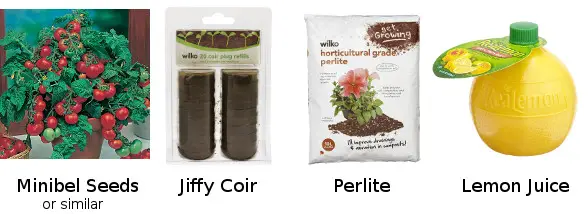Hydroponic tomato growing is a way of growing tomato plants without soil – sometimes called soilless culture.
When growing in soil, water is added which dissolves the nutrients (food) in the soil and plants absorb the moisture with the dissolved food.

When growing without soil, plants can grow in many different mediums such as perlite, mineral wool, coconut husk (coir) or gravel. As long as roots can get hold of water with added nutrients, plants are happy and they grow!
There is a huge industry growing vegetables, and especially tomatoes and sweet peppers hydroponically.
The two most important advantages of this method are, plants produce a higher yield, and secondly, they can be grown anywhere where there’s enough light and warmth. Many of the tomatoes and other vegetables in the supermarket are grown in this way!
So if plants produce a higher yield when grown hydroponically, is it possible to apply one or two of its methods – pick up a few useful tips – that we can use when growing tomatoes in conventional soil? You Bet We Can!
Aeration
Roots need air – I’ll repeat that, roots need air, did I mention that roots need air?
Adding perlite to grow bag and multi-purpose compost is a great way to prevent soil from becoming compacted and water-logged, literally air-less.
Perlite provides both water and air retention and tomato plant roots love it. Add a handful of perlite to compost when potting on and also to grow bags and containers when planting in the final position.
One of the mistakes that is most easy to make is to kill tomato plants with kindness when they are in the pre-fruiting stage of their life cycle by giving them too much water. However, they will be happy to receive lots of water on hot days, when they are fruiting.
Tip: Don’t over-water before they are fruiting.
Nutrients – Feeding
Firstly, shop bought compost contains nutrients (in a general, hit and miss, kind of way) and so it is unnecessary to give extra food to tomato plants until the food in the compost that the plants have been potted into, is used up.
In an ideal world – that of hydroponic growing – plants are given different amounts of the nutrients they need, depending on their stage of growth.
When they are seedlings, they need food suitable for seedlings. When they are developing leaf growth they need food for that, and so on.
When they begin to flower and fruit, they need food for their flowers and fruit development.
Each of these stages requires a different recipe of nutrients. That’s one of the main reasons why hydroponics produces such a good crop – because plants get exactly the type of food they need when they need it!
Babies need baby food, teenagers need food that is suitable for them and adults need time off work, a nice holiday and lots of really great food!!!
Tip: It’s best to feed seedlings at half strength (if at all).
If you feed young seedlings at full strength, they won’t develop a strong root system because they think they won’t need one – their food is brought to them – life is easy!
Wishful thinking aside, we can take a leaf out of the hydroponics book by feeding Organic Liquid Seaweed to seedlings, Miracle Grow (or any balanced feed) to young plants and of course Tomato Food to fruiting plants.
Along with standard tomato food, extra calcium may be added to help avoid blossom end rot and magnesium may be added for conditioning and fruit taste.
At the same time we need to be aware of over-feeding and that compost already contains food that will be dissolved when water is added and absorbed by plant roots.
To Sum Up
Add air to soil by using perlite and use different food for each stage of plant growth.
Other tips include using white reflective surfaces to maximise light – a piece of white paper behind your seedlings can be helpful.
Professional growers add extra carbon dioxide to their greenhouse air which helps plants grow faster. Humans breathe out carbon dioxide, so talking to your plants close-up, may not be such a mad idea after all!
I’m off to have a chat with my seedlings – about hydroponics of course!



sal marino
I am growing tomato plants they are 6 weeks old and the leaves are begin to yellow
Nick
There are many reasons why leaves turn yellow and show signs of nutrient deficiency.
It is usually because they are too cold and wet so roots are unable to absorb nutrients at low temperatures.
Over-watering and over-feeding can also damage or prevent roots functioning properly.
You may find that as the weather warms-up, the plants leaves will improve too. You could give them a foliar spray with a general purpose food like Miracle Grow.
MRS MARY NORCOTT
i have sown 2 different types of tomato seeds in a plastic propagator, on the 18th of March,
on the front bay window
GARDENERS DELIGHT (ALL COME THROUGH) NOW ABOUT 2 INCHES HIGH
GARDEN PEARL (NOT COME THROUGH YET) WHY NOT ANYBODY KNOW ?
REGARDS
MARY NORCOTT MRS
Nick
Hi Andy,
I usually transplant seedlings at around three weeks but a week earlier or later doesn’t make a huge difference. You just have to be a bit more careful with their roots at two weeks as they are more likely to break.
Regards,
Nick
Andy
Hi Nick
My seedlings don’t seem to be a big or as established as yours at 3 weeks. They look a bit more like your 2 week plants. Instead of growing them in a pot I’ve grown them in seed trays could this be the reason and should I still transfer them pr wait another week?
Mark
Hi Andy,
All depends on the type, soil and where they are growing. Perhaps Nick can tell us more about his technique as well as his method.